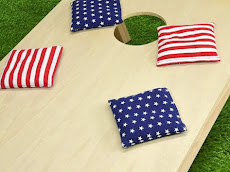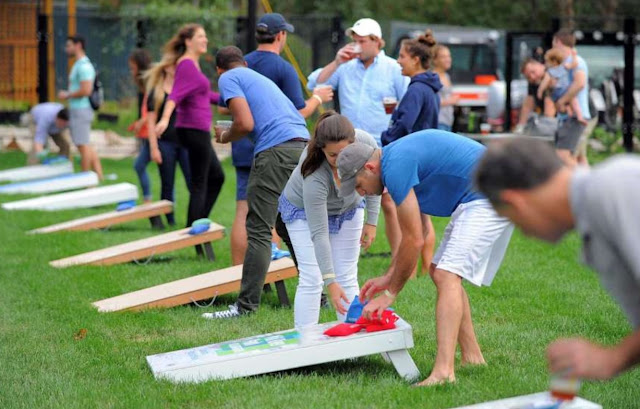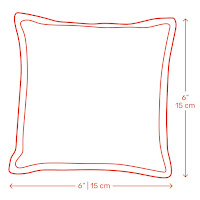How to Make Cornhole Bags - Easy & Fun DIY Tutorial
Have you ever played the game of cornhole? It's a lot of fun and catching. Making your own corn hole bags for the cornhole game is easy, fun and can save you a ton of cash. Check out this tutorial and learn how to make cornhole bags for yourself below.
Of course, you can easily buy some great cornhole bags online, but from time to time it’s fun to have a DIY project that your family and friends can enjoy! If you have a little time and the right equipment, making your own cornhole bags can be a fun challenge.
Cornhole is a game that can be enjoyed by all. While it is easy to be acquainted with the game, it requires skill and technique to best your opponents. The game is adaptable. You can play it as a team or one on one. You can play it indoors or outdoors. All of these factors make it a super fun and timeless game.
You don’t need much to get started. All you need are a few cornhole bags and a cornhole board. Unlike other games, it doesn’t need special equipment. And now thanks to the guide above on how to make cornhole bags yourself, you can enjoy the game with home made equipment.
Players throw small bags at a board with a hole in it. Players earn points by sinking bags in the hole or landing bags on the board. A set of cornhole bags have a total of 8 bags per set, 4 each of 2 different colors.
The American Cornhole Association requires platforms be a 48" x 24" rectangle made from 1/2-inch plywood. The front of the platform stands 2-1/2 to 4 inches tall and the back of the platform sits 12 inches off the ground. The plans for this project follow those requirements.
Regulation corn bags need to be 6-inches square, made from duck canvas and be filled with two cups of corn feed.
Cornhole bags are not made to last forever, but I have a secrets recipe to share with you that will help you get the most life and perfect play out of your bags.
Using the following instructions, you’ll be able to create regulation-size bags as set by the American Cornhole Organization.
To make a set of strong and sturdy cornhole bags, we used Cotton Duck material. It is a soft, easy-to-sew material and is strong enough to stand up to the abuse of being tossed around. The bags are sewn with a double stitch around the inner sides, according to the American Cornhole Organization’s regulations. For the stuffing inside, we used feed corn, which is traditional, but you can also use beans or plastic pellets. To have your bags regulation compliant, each bag should contain approximately 1-3/4 cup of corn to weigh between 15-16 oz.
Step 1: Cut out sixteen 7-inch squares, 8 squares of each color.
Cut out 7” strips from two different colors of fabric with the help of a ruler and a rotary cutter. Then divide each strip into four 7” squares. You will need a total of sixteen 7” squares, 8 squares of each color. Spare about ½” of fabric on the edges for the ease of stitching.
For more precision, you should first cut out the 7”x7” on a cardboard to make a stencil. Then firmly place this stencil on the cloth, take a marker and start tracing. After measuring 8 squares, cut them out. Easy-peasy.
Step 2: Start sewing 3 sides ½ inch from the raw edges
Next up, take two pieces of fabric, line them up for sewing. Adjust your sewing machine for straight stitching at medium speed. Start sewing the sides ½ inch from the raw edges. Do a double stitching to prevent the bag from bursting while throwing around.
Fully stitch 3 sides and leave a small gap on the 4th side for filling the bag. Chop off the corners before flipping your bag inside out.
Step 3: Fill the Bag with 15 Oz of filling (Corn or Plastic)
After cutting the corners, turn the bag inside out. Use a pen or something to poke out the corners.
Next, measure 2 cups of whole corn or plastic pellets for stuffing. Use a digital scale to accurately measure out 15 Oz. of filling. Stick a wide funnel into the gap you left while stitching and start loading the corn. When done, seal the mouth with two pins as close to the edge as possible.
Step 4: Finally Stitch the open side
This is the final step of this process. This time, you will have to sew the thicker side which could be a little tricky for beginners.
Have patience, take your time and always put double stitching. Go for triple stitching if possible. Sew the entire length of the edges for a great finish. For best results, use zig-zag stitch for the final stitching if your machine has this option.
Now you're ready to get outside and throw some cornhole bags! The whole process should take at least an hour or two to cut and sew cornhole bags yourself depending on your sewing ability. Do you and your family and friends play cornhole or other yard games? What’s your favorite summertime game? Share your thoughts and stories with us in the comments!
Of course, you can easily buy some great cornhole bags online, but from time to time it’s fun to have a DIY project that your family and friends can enjoy! If you have a little time and the right equipment, making your own cornhole bags can be a fun challenge.
How to Play Cornhole Game?
Cornhole is a game that can be enjoyed by all. While it is easy to be acquainted with the game, it requires skill and technique to best your opponents. The game is adaptable. You can play it as a team or one on one. You can play it indoors or outdoors. All of these factors make it a super fun and timeless game.
You don’t need much to get started. All you need are a few cornhole bags and a cornhole board. Unlike other games, it doesn’t need special equipment. And now thanks to the guide above on how to make cornhole bags yourself, you can enjoy the game with home made equipment.
Players throw small bags at a board with a hole in it. Players earn points by sinking bags in the hole or landing bags on the board. A set of cornhole bags have a total of 8 bags per set, 4 each of 2 different colors.
The American Cornhole Association requires platforms be a 48" x 24" rectangle made from 1/2-inch plywood. The front of the platform stands 2-1/2 to 4 inches tall and the back of the platform sits 12 inches off the ground. The plans for this project follow those requirements.
Regulation corn bags need to be 6-inches square, made from duck canvas and be filled with two cups of corn feed.
Steps for How to Make Cornhole Bags
Cornhole bags are not made to last forever, but I have a secrets recipe to share with you that will help you get the most life and perfect play out of your bags.
Using the following instructions, you’ll be able to create regulation-size bags as set by the American Cornhole Organization.
To make a set of strong and sturdy cornhole bags, we used Cotton Duck material. It is a soft, easy-to-sew material and is strong enough to stand up to the abuse of being tossed around. The bags are sewn with a double stitch around the inner sides, according to the American Cornhole Organization’s regulations. For the stuffing inside, we used feed corn, which is traditional, but you can also use beans or plastic pellets. To have your bags regulation compliant, each bag should contain approximately 1-3/4 cup of corn to weigh between 15-16 oz.
Supplies
12 oz. duck canvas, 1/4 yard each of two colors
Quality feed corn, 15 oz. for each corn bag (or use 15 oz. dried beans)
Zipper foot
5-in-1 Sliding Gauge (optional)
Clover Point 2 Point Turner (optional)
Wonder Clips (optional)
Quality feed corn, 15 oz. for each corn bag (or use 15 oz. dried beans)
Zipper foot
5-in-1 Sliding Gauge (optional)
Clover Point 2 Point Turner (optional)
Wonder Clips (optional)
Instructions
Step 1: Cut out sixteen 7-inch squares, 8 squares of each color.
Cut out 7” strips from two different colors of fabric with the help of a ruler and a rotary cutter. Then divide each strip into four 7” squares. You will need a total of sixteen 7” squares, 8 squares of each color. Spare about ½” of fabric on the edges for the ease of stitching.
For more precision, you should first cut out the 7”x7” on a cardboard to make a stencil. Then firmly place this stencil on the cloth, take a marker and start tracing. After measuring 8 squares, cut them out. Easy-peasy.
Step 2: Start sewing 3 sides ½ inch from the raw edges
Next up, take two pieces of fabric, line them up for sewing. Adjust your sewing machine for straight stitching at medium speed. Start sewing the sides ½ inch from the raw edges. Do a double stitching to prevent the bag from bursting while throwing around.
Fully stitch 3 sides and leave a small gap on the 4th side for filling the bag. Chop off the corners before flipping your bag inside out.
Step 3: Fill the Bag with 15 Oz of filling (Corn or Plastic)
After cutting the corners, turn the bag inside out. Use a pen or something to poke out the corners.
Next, measure 2 cups of whole corn or plastic pellets for stuffing. Use a digital scale to accurately measure out 15 Oz. of filling. Stick a wide funnel into the gap you left while stitching and start loading the corn. When done, seal the mouth with two pins as close to the edge as possible.
Step 4: Finally Stitch the open side
This is the final step of this process. This time, you will have to sew the thicker side which could be a little tricky for beginners.
Have patience, take your time and always put double stitching. Go for triple stitching if possible. Sew the entire length of the edges for a great finish. For best results, use zig-zag stitch for the final stitching if your machine has this option.
Now you're ready to get outside and throw some cornhole bags! The whole process should take at least an hour or two to cut and sew cornhole bags yourself depending on your sewing ability. Do you and your family and friends play cornhole or other yard games? What’s your favorite summertime game? Share your thoughts and stories with us in the comments!




























